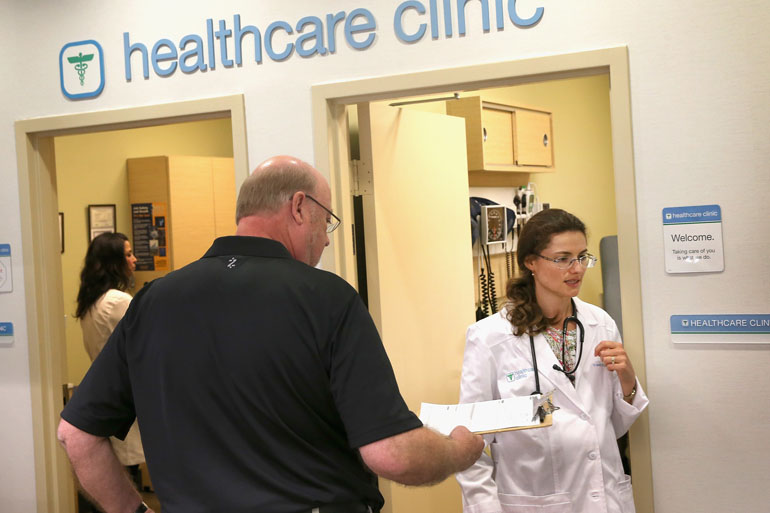Retail clinics, long seen as an antidote to more expensive doctor offices and emergency rooms, may actually boost medical spending by leading consumers to get more care, a new study shows.
Rather than substituting for a physician office visit or trip to the hospital, 58 percent of retail clinic visits for minor conditions represented a new use of medical services, according to the study published Monday in the journal Health Affairs. Those additional visits led to a modest increase in overall health care spending of $14 per person per year.
“This challenges the conventional wisdom that retail clinics save the health care system money,” said Dr. Ateev Mehrotra, a co-author of the study and an associate professor of health care policy at Harvard Medical School. “The increase in spending from new utilization trumps the savings we saw from replacing doctor visits and the emergency department.”
There are more than 2,000 in-store clinics nationwide, and they handle about 6 million patient visits annually, the study said.
They are popular with many consumers who like strolling in for care with no appointment, as opposed to waiting hours elsewhere, and they are open seven days a week. These small clinics are typically run by nurse practitioners and treat infections, mild sprains and handle other preventive care such as immunizations.
CVS Health Corp.’s MinuteClinic is the industry leader with more than 1,100 locations. Many health insurers and employers encourage people to use these clinics, in some cases waiving co-payments.
But Mehrotra said policymakers and health insurers should realize that promoting more convenient options, from retail clinics to online doctor visits, may spur more use and higher costs.
“As we make things more convenient people will use it a lot more,” said Mehrotra, also a researcher at Rand Corp., a nonprofit think tank in Santa Monica, Calif.
The study doesn’t contradict earlier research that found retail clinics provide care that costs 30 to 40 percent less than similar care provided at a physician’s office and that the treatment for routine illnesses was of similar quality. But it suggests those savings are more than offset by increased use of medical services.
Dr. Andrew Sussman, president of the MinuteClinic unit at CVS, criticized the study as “flawed” and too reliant on old data. He said about half of MinuteClinic patients don’t have a regular family physician and his clinics are able to prevent minor conditions from becoming major illnesses requiring costlier care.
The study “is not an accurate assessment of retail clinic cost savings and value,” Sussman said. “It is a step backward to think of people who did not have a primary-care physician and get care as excess utilization.”
The study’s authors couldn’t assess the impact retail clinics have on overall medical use and total spending because they didn’t have data on inpatient care or prescription drug use — two large components of health care spending.
The researchers looked at data on 3 million Aetna Inc. members from 2010 to 2012 and their medical use tied to 11 low-acuity conditions, such as sinusitis and urinary tract infections. The patients were divided between users of retail clinics and people who did not visit them.
Aetna, the nation’s third-largest health insurer, said it remains supportive of retail clinics and looks forward to further studies examining the longer-term impact on costs and patient outcomes. In particular, Aetna and other health care purchasers want to know if retail clinics can help diabetics and others battling costly chronic illnesses.
“Retail clinics are a convenient and flexible option that are available during extended hours, while traveling, and for minor health needs,” the company said in a statement. “They are also a good option for consumers who do not have a primary-care physician.”
In this latest study, researchers found that much of the new use was for ailments that typically cleared up on their own, such as a fever, cough or runny nose. But Mehrotra said he doesn’t want the study to be seen as criticizing people for seeking medical help. Rather, he wants to emphasize that convenience is going to increase utilization.
“If the retail clinics wouldn’t have been around, people would have stayed home,” he said. “New utilization accounts for most retail clinic visits.”
The researchers noted some limitations to the study. It was confined to the commercial insurance population, excluding people on Medicare, Medicaid or the uninsured. It didn’t factor in benefits such as the time saved by going to a retail clinic.
And Mehrotra said this study focused on the initial visit. It looked at whether it was new utilization or replaced a more expensive option. Among visits deemed to be substitution, 93 percent replaced a doctor visit and 7 percent were in place of going to an emergency room.
Tom Charland, an industry analyst and chief executive of research firm Merchant Medicine, said retailers have had mixed results with these in-store clinics. CVS and Kroger Co. continue to open new locations while Wal-Mart Stores Inc. and Target Corp. pulled back on the business after lackluster results, he said.
These clinics have been seen as one way to address a lack of primary-care doctors in some areas of the country as the federal health law expands insurance coverage to millions of Americans. Some major health systems, including the Cleveland Clinic and UCLA, have partnered with retail clinics to help meet the increased demand.
Sussman said about half of MinuteClinic patients are seen on weekends or during evening hours when most physician offices are closed. “The Affordable Care Act is bringing millions of new patients into the system, and it’s necessary to provide alternate types of care,” Sussman said.
But Mehrotra said health plans and employers should carefully consider how they cover care at retail clinics. “If the goal is to lower costs,” he said, “then encouraging use of retail clinics may not be a successful strategy.”
This story was produced by Kaiser Health News, which publishes California Healthline, a service of the California Health Care Foundation.







